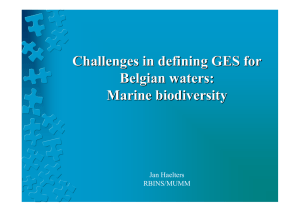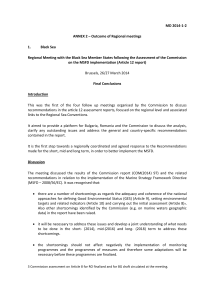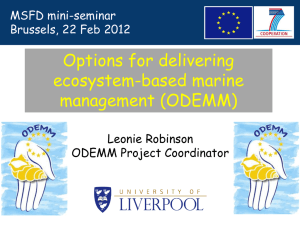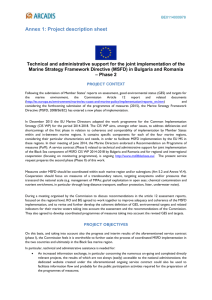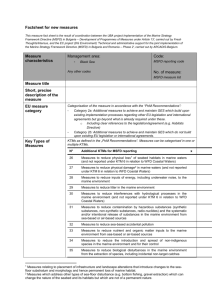The Marine Strategy Framework Directive: Cementing monitoring
advertisement
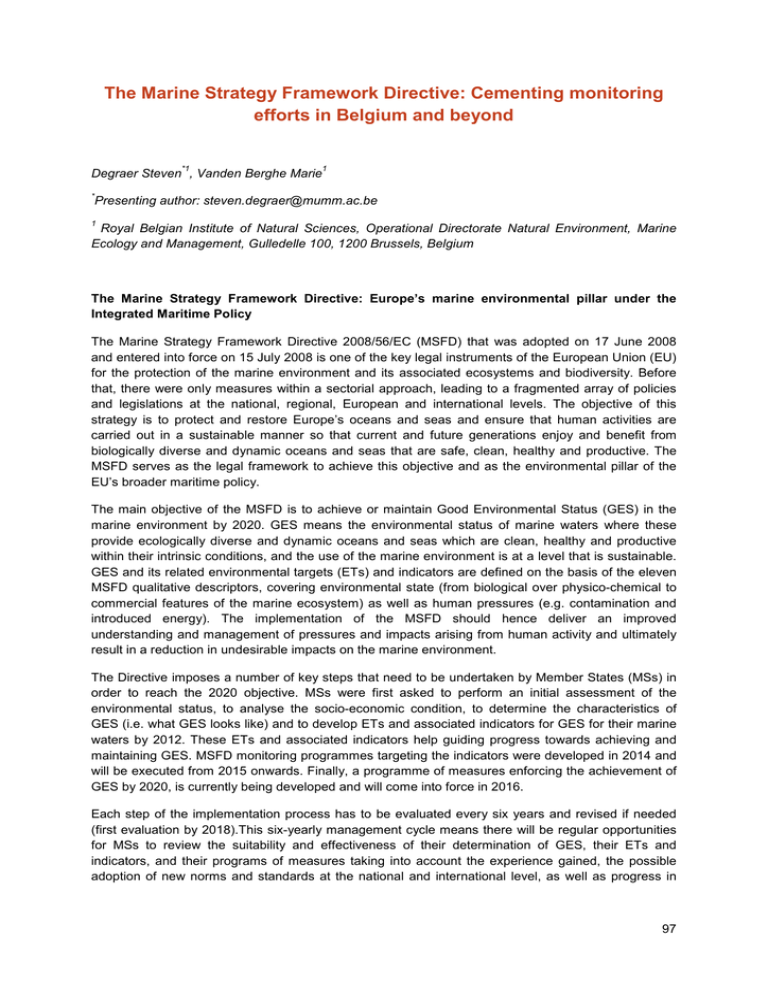
The Marine Strategy Framework Directive: Cementing monitoring efforts in Belgium and beyond *1 1 Degraer Steven , Vanden Berghe Marie * Presenting author: steven.degraer@mumm.ac.be 1 Royal Belgian Institute of Natural Sciences, Operational Directorate Natural Environment, Marine Ecology and Management, Gulledelle 100, 1200 Brussels, Belgium The Marine Strategy Framework Directive: Europe’s marine environmental pillar under the Integrated Maritime Policy The Marine Strategy Framework Directive 2008/56/EC (MSFD) that was adopted on 17 June 2008 and entered into force on 15 July 2008 is one of the key legal instruments of the European Union (EU) for the protection of the marine environment and its associated ecosystems and biodiversity. Before that, there were only measures within a sectorial approach, leading to a fragmented array of policies and legislations at the national, regional, European and international levels. The objective of this strategy is to protect and restore Europe’s oceans and seas and ensure that human activities are carried out in a sustainable manner so that current and future generations enjoy and benefit from biologically diverse and dynamic oceans and seas that are safe, clean, healthy and productive. The MSFD serves as the legal framework to achieve this objective and as the environmental pillar of the EU’s broader maritime policy. The main objective of the MSFD is to achieve or maintain Good Environmental Status (GES) in the marine environment by 2020. GES means the environmental status of marine waters where these provide ecologically diverse and dynamic oceans and seas which are clean, healthy and productive within their intrinsic conditions, and the use of the marine environment is at a level that is sustainable. GES and its related environmental targets (ETs) and indicators are defined on the basis of the eleven MSFD qualitative descriptors, covering environmental state (from biological over physico-chemical to commercial features of the marine ecosystem) as well as human pressures (e.g. contamination and introduced energy). The implementation of the MSFD should hence deliver an improved understanding and management of pressures and impacts arising from human activity and ultimately result in a reduction in undesirable impacts on the marine environment. The Directive imposes a number of key steps that need to be undertaken by Member States (MSs) in order to reach the 2020 objective. MSs were first asked to perform an initial assessment of the environmental status, to analyse the socio-economic condition, to determine the characteristics of GES (i.e. what GES looks like) and to develop ETs and associated indicators for GES for their marine waters by 2012. These ETs and associated indicators help guiding progress towards achieving and maintaining GES. MSFD monitoring programmes targeting the indicators were developed in 2014 and will be executed from 2015 onwards. Finally, a programme of measures enforcing the achievement of GES by 2020, is currently being developed and will come into force in 2016. Each step of the implementation process has to be evaluated every six years and revised if needed (first evaluation by 2018).This six-yearly management cycle means there will be regular opportunities for MSs to review the suitability and effectiveness of their determination of GES, their ETs and indicators, and their programs of measures taking into account the experience gained, the possible adoption of new norms and standards at the national and international level, as well as progress in 97 scientific knowledge and instrumentation. The 2018 evaluation will provide the basis for such a review for the second cycle of 2018-2024. Implementing the Marine Strategy Framework Directive in Belgian waters The MSFD was transposed by Belgium into the Royal Decree of June 23, 2010. Belgium completed the first step of implementation in July 2012 with the publication of three reports that can be can be downloaded from http://www.health.belgium.be/eportal/Environment/MarineEnvironment/TheMarineEnvironPolicy/Worki ngInAnInternational/MarineStrategy/index.htm?fodnlang=en#.UujXkbRKHs0. The Belgian 2012 report on GES for Belgian waters comprises 50 ETs which are to be complied with to have reached GES in Belgian waters. In September 2014, Belgium reported its marine monitoring programmes for the Belgian part of the North Sea (BPNS) to the Commission. For more detailed information on the implementation of the MSFD in Belgian waters, see http://www.msfd-monitoring.be. Zooming into indicators, environmental targets and monitoring programmes relevant for marine aggregate extraction in Belgian waters. From the list of 50 ETs, 11 prove highly to marginally relevant for the marine aggregate extraction sector. In decreasing order of relevance, those are: 1. The spatial extent and distribution of the EUNIS level 3 habitats (sandy mud to mud, muddy sands to sands and coarse grained sediments), as well as that of gravel beds fluctuate - relative to the reference state as described in initial assessment - within a margin limited to the accuracy of the current distribution maps. 2. The Ecological Quality Ratio as determined by Benthic Ecosystem Quality Index (BEQI), indicative for benthic ecosystem structure and quality, has a minimum value of 0,60 in each of the habitat types. 3. No positive trend in the yearly mean ambient noise level within the 1/3 octave bands 63 and 125 Hz. 4. An impact demands consideration if one of the following conditions – related to the bottom stress on a 14 days spring tide/neap tide cycle as computed by validated mathematical models – is met: a. there is an increase of more than 10% of the mean bottom shear stress b. the variation of the ratio between the duration of the bottom shear stress and the duration of the erosion is outside the “- 5%, + 5%” range 5. This consideration demanding impact remains within a distance equal to the root square of the surface occupied by this activity and taken from its external limit. All developments must comply with the existing regulatory regime (e.g. EIA, SEA, and Habitats Directives) and regulatory assessments must be undertaken in such a way that takes into consideration any potential impacts arising from permanent changes in hydrographical conditions, including cumulative effects, at the most appropriate spatial scales following the guidance prepared to this end. 6. Within the test zones in the gravel beds, the ratio of the hard substrate surface area (i.e. surfaces that are colonized by hard substrate epifauna) over soft sediment surface area (i.e. surfaces overtopping hard substrates and preventing hard substrate fauna development) does not show a negative trend. 7. Positive trend in median adult density (or frequency of occurrence) of at least one species within the long-lived and/or slowly reproducing and key engineering benthic species groups in … pure fine to coarse sands (i.e. larger bivalves such as Laevicardium crassum, Glycymeris glycymeris and Dosinia exoleta; larger gallery-dwelling organisms such as Upogebia deltaura and Corystes cassivelaunus). 8. Introduction of new human induced non-indigenous species of macrofauna and macroflora (>1 mm) in relation to the 2012 baseline is prevented. Species for which there are taxonomic disputes and for which the changes of permanent introduction, including reproduction are negligible are not taken into consideration. 98 9. Acute pollution: occurrence and extent of significant acute pollution events (e.g. slicks resulting from spills of oil and oil products or spills of chemicals) and their impact on biota affected by this pollution should be minimised through appropriate risk based approaches. 10. Biota and oil: the average proportion of oiled common guillemots (zeekoet - Uria aalge) is below 20 % of the total number found dead or dying on the beaches. 11. Positive trend in the number of individuals of thornback ray Raja clavata. Whether or not an ET is met, is assessed through the Belgian package MSFD monitoring programmes, reported to the EU Commission in October 2014 and to be executed from 2015 onwards. Five monitoring sub-programmes developed for the most relevant ETs described above and hence most relevant to the marine aggregate extraction sector, can be discerned: • • • • • ANSBE-D1, 4, 6 Seabed-SP5 (delivering data to assess ET7), targeting a full-coverage seabed and transect seabed mapping of selected areas at EUNIS level 3; ANSBE-D1, 4, 6 Seabed-SP6 (delivering data to assess ET10), targeting the quantification of a composite index based on density, biomass, species richness and species composition of the macrobenthos at selected stations in the BPNS; ANSBE-D11 Energy-SP30 (delivering data to assess ET50), targeting the quantification of ambient noise level at 1 moored station inside the Belgian Continental Part of the North Sea; ANSBE-D7 Hydrography- SP16 (delivering data to assess ET29 and 30), targeting change in elevation, 3D currents, bottom shear stress using a validated numerical model. This programme will be performed during each licensing procedure regarding human construction at sea; ANSBE-D1, 4, 6 Seabed-SP10 (delivering data to assess ET17), targeting multibeam bathymetry and backscatter measurements in combination with visual observations and seabed sampling in a gravel bed in the Hinder Banks region and a gravel bed in the Flemish Banks region. What’s next? A FRAMEWORK FOR ENVIRONMENTAL LICENSING AND IMPACT MONITORING The MSFD sets a series of environmental targets to achieve GES by 2020. The MSFD hence provides an ideal framework for environmental licensing and impact monitoring of human activities at sea. Human activities compromising achieving GES should be maximally avoided or mitigated to the benefit of an environment-friendly exploitation activities and techniques. Distinguishing between significant and non-significant impacts is of utmost importance here. While until now such distinction was left to expert judgement inherent to the environmental impact assessment procedure, we now have a well-deliberated reference framework against which (predicted) impacts can be assessed and valued. In a context of marine aggregate extraction in Belgian waters, especially the above mentioned eleven environmental targets will need specific consideration. Also the post-decision monitoring can now be targeted more transparently and objectively, because such monitoring may now set priorities based not only on impact magnitude (i.e. size of the impact), but also impact significance (i.e. importance for decision-making). In case of knowledge gaps to properly assess the interaction between the human activity and achieving GES, the monitoring may now also target addressing these knowledge gaps as to lower impact assessment uncertainty (for future licensing procedures) within the MSFD assessment framework. It should however also be clear that next to the MSFD also other (environment-driven) legislation is applicable to Belgian waters, e.g. the Habitats and Birds Directives, each of which with specific (conservation) objectives and hence all completing the scene for environmental impact assessment and monitoring. 99 A FRAMEWORK FOR CONTEXT SETTING AND INTEGRATION The MSFD provides a framework to move away from an assessment of how much an impact site deviates from a reference location to how an impact compares to the desired environmental status of the Belgian part of the North Sea and by extension, the North Sea as a whole. As such an impact assessment is being put into a wider perspective, which opens the door to better address the most important “so what” question: does it really matter... In other words, while until now the impact size is quantified for a given human activity without reference to other activities, we now have the possibility to also qualify the impact against the impacts of other human activities and hence to relativize humaninduced impacts. Such setting the scene, will better allow for an objective evaluation of impact and its consequent need for mitigating measures for a given activity, compared to other human activities. While targeting such wider perspective, moving away from formerly sector-oriented monitoring programmes to an integrated MSFD monitoring programme, will now also facilitate a higher level of efficiency and effectiveness of the monitoring programmes. The ecological status of sites impacted by various human activities, can now be compared with a series of reference sites, which will drastically increase detection power and hence the likelihood of a correct impact quantification. The integrated MSFD monitoring programme will as such offer a good platform to simultaneously assess impacts of multiple human activities and to advise on where the programme of measures should focus. A challenging, yet exciting and promising way forward. STAKEHOLDERS ALLOWED! The MSFD is not only directed to national environmental authorities but also towards all stakeholders, specifically those who have an interest in marine affairs, such as industries with economic activities at sea, environmental NGOs, research centres,… An active participation of those stakeholders is therefore highly recommended and is more than beneficial to achieve a coherent and harmonious implementation of the MSFD. The Directive indeed foresees a transparent decision-making process allowing stakeholders to express their vision on the proposed indicators and environmental targets, monitoring programmes and the future programme of measures. Public consultation hence is required at the end of each step of the implementation and is one of way in which stakeholders can influence decision-making (see figure 1). In addition, stakeholders were invited to and actively contributed to workshops aiming at the definition of GES for Belgian waters. Moreover, the six-yearly management cycle will provide regular opportunities for stakeholders’ participation in order to assess the effectiveness, quality and comprehensiveness of indicators and environmental targets, monitoring programmes and measures. The identification of gaps and issues and suggestions on how to do better in the future would be most welcome. In other words, your opinion counts. 100
